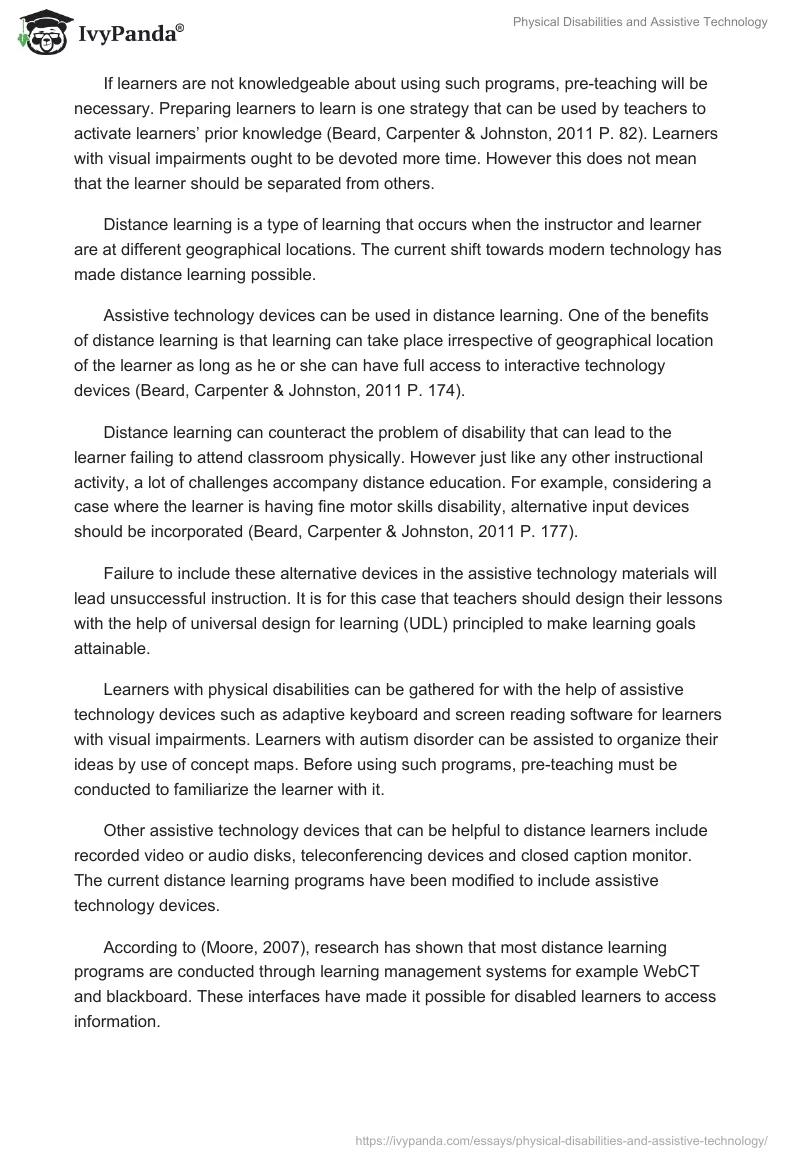Modern classrooms are characterized by learners with diverse learning capabilities. There is no specific method of instruction which can gather for all the learners. Teachers are confronted with a challenge of teaching students with different disabilities. Assistive technology has made it possible for educators to gather for learners with various disabilities.
Assistive technology is defined as any item, software or equipment that has been customized to enhance the functional capability of learners with disabilities (Beard, Carpenter & Johnston, 2011 P. 5). Various technological equipments have been designed to provide support to learners with challenges.
For example, learners with visual impairments can use text-to-speech programs. Text-to-speech programs do have the capability of scanning and reading printed text to create digitized speech (Beard, Carpenter & Johnston, 2011 P. 74). These programs promote independence because they can be used to download electronic learning resources. A teacher may not be required to read text for learners with visual impairments.
For learners with partial visual impairment, text enlargement programs have been designed. The common characteristic of these assistive technology items is that they can be integrated with computers.
This makes it easy to manipulate information to suit particular learners’ needs. Technology creates an opportunity for teachers to customize education especially with the use of digital texts to meet individual needs (Hall, Meyer, & Rose, 2012 P.11).
Considering a case where a teacher is dealing with blind learners and he or she is teaching mathematics, an audible graphing calculator for example will be of great use. An audible graphing calculator is a program designed for visual impairments (Beard, Carpenter & Johnston, 2011 P. 81). It has both visual and verbal capabilities. Before using such programs, the teacher should provide computers to the learners.
If learners are not knowledgeable about using such programs, pre-teaching will be necessary. Preparing learners to learn is one strategy that can be used by teachers to activate learners’ prior knowledge (Beard, Carpenter & Johnston, 2011 P. 82). Learners with visual impairments ought to be devoted more time. However this does not mean that the learner should be separated from others.
Distance learning is a type of learning that occurs when the instructor and learner are at different geographical locations. The current shift towards modern technology has made distance learning possible.
Assistive technology devices can be used in distance learning. One of the benefits of distance learning is that learning can take place irrespective of geographical location of the learner as long as he or she can have full access to interactive technology devices (Beard, Carpenter & Johnston, 2011 P. 174).
Distance learning can counteract the problem of disability that can lead to the learner failing to attend classroom physically. However just like any other instructional activity, a lot of challenges accompany distance education. For example, considering a case where the learner is having fine motor skills disability, alternative input devices should be incorporated (Beard, Carpenter & Johnston, 2011 P. 177).
Failure to include these alternative devices in the assistive technology materials will lead unsuccessful instruction. It is for this case that teachers should design their lessons with the help of universal design for learning (UDL) principled to make learning goals attainable.
Learners with physical disabilities can be gathered for with the help of assistive technology devices such as adaptive keyboard and screen reading software for learners with visual impairments. Learners with autism disorder can be assisted to organize their ideas by use of concept maps. Before using such programs, pre-teaching must be conducted to familiarize the learner with it.
Other assistive technology devices that can be helpful to distance learners include recorded video or audio disks, teleconferencing devices and closed caption monitor. The current distance learning programs have been modified to include assistive technology devices.
According to (Moore, 2007), research has shown that most distance learning programs are conducted through learning management systems for example WebCT and blackboard. These interfaces have made it possible for disabled learners to access information.
References
Beard, L. A., Carpenter, L. B. & Johnston, L. B. (2011). Assistive Technology: Access for All Students (2 nd ed.). Upper Saddle River, NJ: Pearson Education, Inc.
Hall, E. T., Meyer, A. & Rose, H. (2012). Universal Design for Learning in the Classroom: What works for Special Needs Learners? New York: Guilford Press.
Moore, M. G. (2007). Handbook of Distance Education. New York: Routledge.


